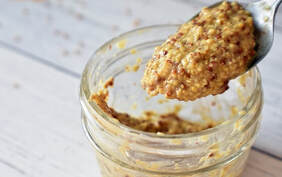
Fermented foods are a powerhouse of nutrition and provide great support to your microbiome, so if you haven't tried making your own yet, I highly encourage you to jump in and give it a try! Most fermented foods are extremely simple - some with just 2 ingredients like this easy sauerkraut recipe, and others with more ingredients like my absolute favorite fermented salsa (which is actually even easier to make than the sauerkraut if you use a food processor).
Either way, fermented foods are generally easy and very safe to make at home, and you'll be amazed at how fermentation can transform the plainest vegetables into a bounty of savory flavors!
This week, I'm sharing a unique one with you. This zesty condiment is something you'll never want to be without, and it's super easy to make at home!
Mustard is a classic condiment with a tangy, spicy flavor, and you can find it in several different forms, from the quintessential smooth yellow, to tangy Dijon, to whole-grain mustards of various flavors and varieties. All mustard condiments are made using mustard seeds, combined with a few other ingredients such as vinegar and salt.
Mustard seeds come in three varieties: white (or yellow), brown, and black, with white being the mildest and most common, and black having the strongest flavor.
Depending on your preference, you may choose to make your homemade fermented mustard with any of the three types of mustard seed, or a combination. Fermentation adds another level of complexity and a funky tang to your mustard that makes it even more interesting and tasty!
Naturally Fermented Mustard Recipe
Equipment Needed:
- Spice Grinder or mortar and pestle (to crack the seeds)
- 1 Pint Jar
- Regular jar lid or fermentation lid with airlock
- Blender
- ¾ Cup Yellow (White) Mustard Seeds (or use half Yellow and half Black or Brown if a spicier taste is desired)
- 2 tsp of salt
- ½ tsp turmeric powder
- 1 tsp of whey (real whey, not powdered), or brine from a previous lacto-fermentation (sauerkraut, kimchi, or other pickled vegetable brine works great)
- 1 ½ cups of filtered or de-chlorinated water (DO NOT USE regular tap water without removing the chlorine - it will ruin your ferment!)
- 1 clove of garlic
Instructions:
Step 1: Crack the mustard seeds open using a spice grinder or mortar and pestle. Cracking the seeds open will allow the release of more flavor while they ferment.
Step 2: In a pint jar, combine the mustard seeds, salt, turmeric, garlic, and whey/brine.
Step 3: Cover the ingredients with water
Step 4: Close the jar using your fermentation lid or a regular lid.
Step 5: Let your mustard sit at room temperature for 5-10 days (depending on your taste; taste it every few days until it tastes tangy enough for you). If you are using a regular lid, you will need to “burp” the mustard every couple of days to prevent gas buildup.
Step 6: Drain the excess liquid from the jar, and then blend the remaining contents in a blender until you have reached the desired consistency.
Step 7: Put your blended mustard back into the jar and place it in your refrigerator. Let it age for 2-3 days and then give it a taste test. Note: Mustard naturally has a bitter taste but it will become milder and less bitter the longer it sits in your refrigerator.
You can store your homemade lacto-fermented mustard in the refrigerator for 6 months or more.
Enjoy!
Rose.
Recipe Source: ThePrairieHomestead.com



 RSS Feed
RSS Feed